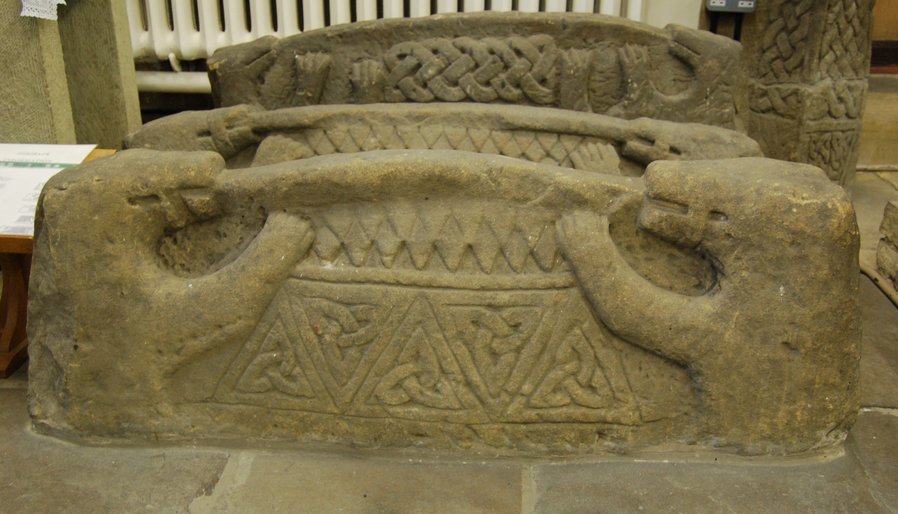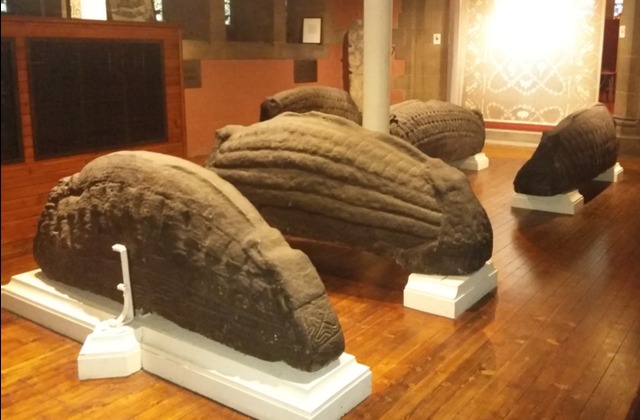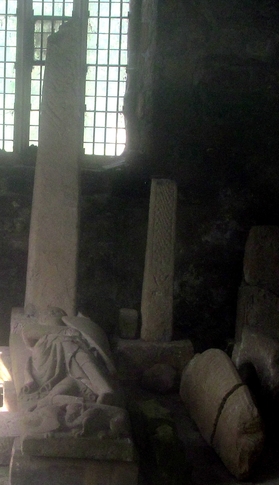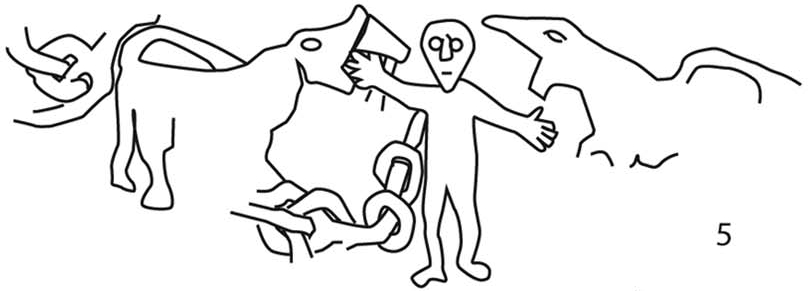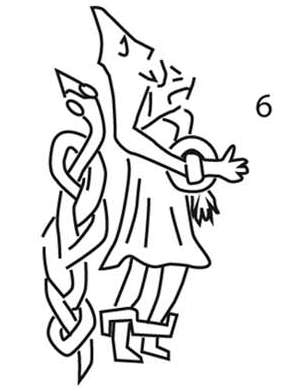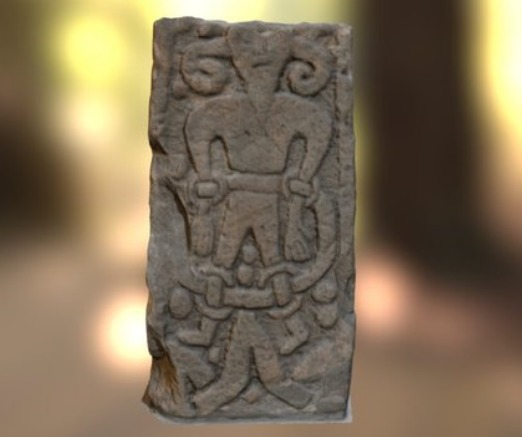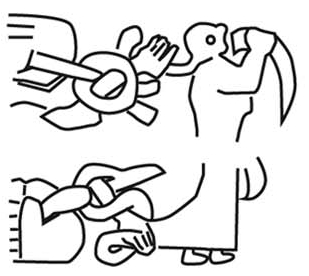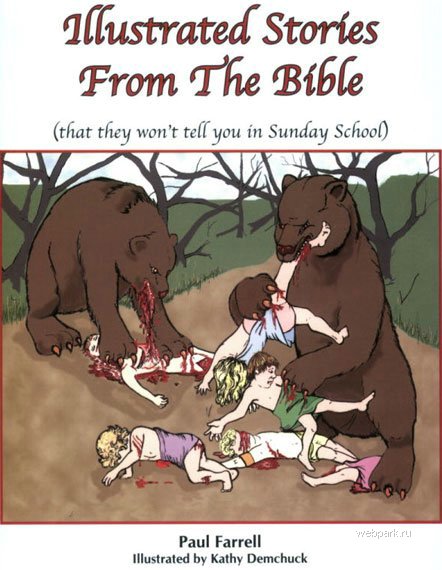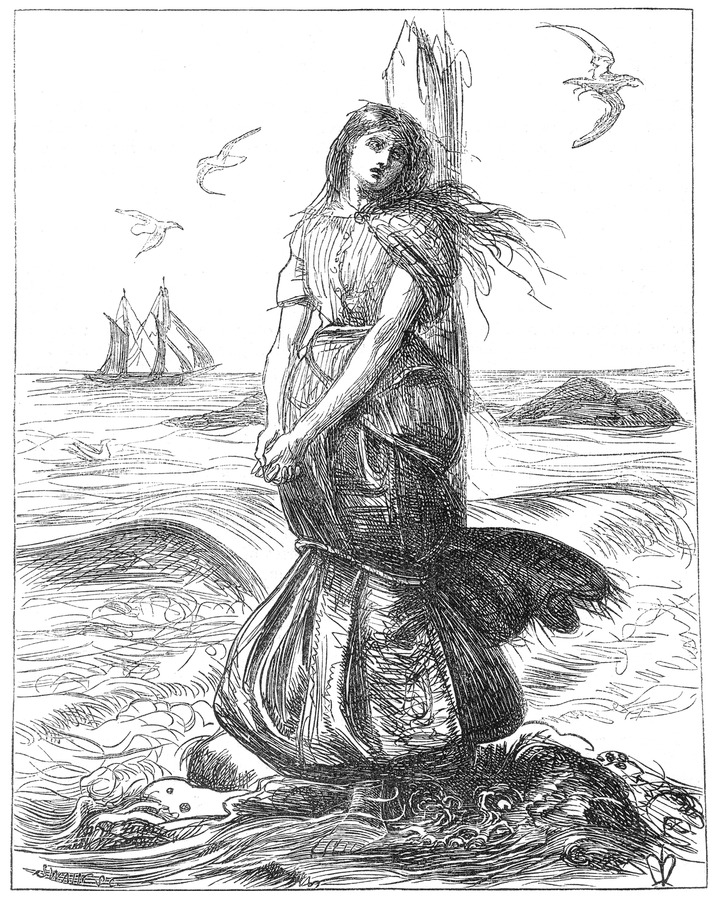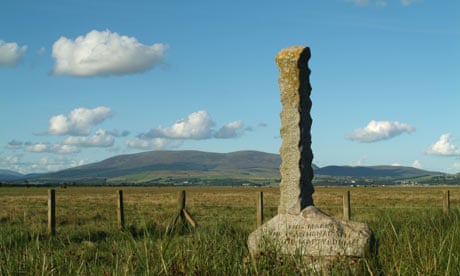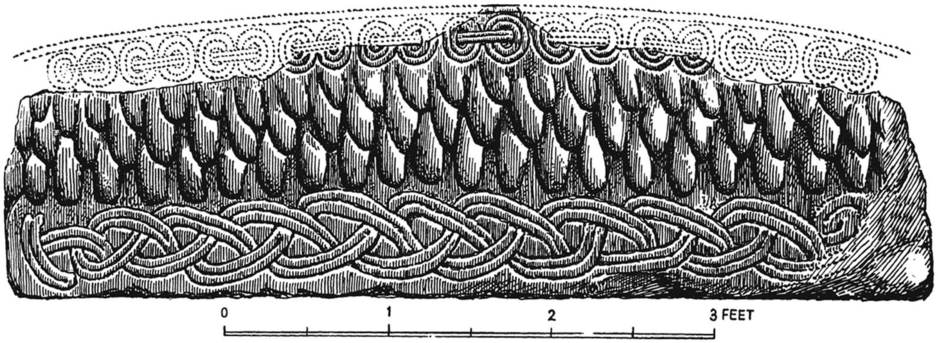Hogback 'tombs' intimately connect four English words: 'stock', 'stocks', 'grave' and 'gravy'. Wed 15 June 2022
Feeding the animals. St Thomas Church, Brompton, West Yorkshire. Source: Hogback Tombstone Research Journal
144 hogback stones have been found in the British Isles.
Historians claim they are tombstones built to symbolise Viking houses. Except for Victoria Whitworth, that is, who suggests they represent human bodies.
Historians know hogbacks are Viking because no trace of a hogback has ever been found in Scandinavia.
From Understanding the Heysham hogback: A tenth-century sculpted stone monument and its context, by Thor Ewing:
The hogback is thus a wholly British phenomenon (there is one lone example in Ireland)
Whatever they were and wherever the idea for them came from, hogbacks were not tombstones.
From Understanding the Heysham Hogback:
no grave has been found in clear association with one of these stones
And from Hogback Tombstone Research Journal:
Very few hogbacks are long enough to cover the entire length of the grave
One thing everyone agrees is that hogbacks depict animals.
From Viking Hogbacks:
One of the distinct features of the hog-backs is the end-beasts placed on the gables.
And from Hogback Tombstone Research Journal:
They are characterized by carvings of bears hugging the slabs with strapwork in their mouths.
Some think the 'bears' are boars: wild pigs.
The heads of hogback bears - or hogback boars, if you prefer - are usually flattened. As if something was laid along the hogback ridge and weighed down at each end.
Possibly, these hogbacks were lamination formers. That is, formers for holding and clamping layers of yew, bone and/or sinew while gluing composite bows, beams or spars. Or furniture parts. In that usage, the glue - also made from animal parts - would drip down the side of the hogback.
However, orthodox historians claim only the natives of America, Asia and the Arctic mastered lamination. The natives of Yorkshire - where most flat-headed bear and boar-headed hogbacks are found - are not conventionally thought to have mastered the complexities of lamination.
In north west England and Scotland, flat headed bears or boars don't feature as hogback-ends. Instead they went for reptiles. Possibly serpents. Such as the hogbacks at Govan Parish Church, Glasgow, Scotland:
Govan Stones, Glasgow. Source: Govan Old Parish Church
From Hogback Tombstone Research Journal:
many hogbacks from north west England and Scotland have a snake hugging the bottom or top of the monument. The large clasping bears feature mainly on Yorkshire hogbacks
There is evidence that hogbacks were usually sited next to tall stone shafts. These now-destroyed shafts are usually labelled as 'high crosses':
Hogbacks and high crosses at The Giant's Grave, St Andrews, Penrith. Source
From The Giant's Grave:
Both crosses have sustained some damage – the taller cross with a badly damaged head is between 11 and 12 foot high, while the smaller cross, also without its head is between 10 and 11 foot high.
And from Hogback Monuments in Scotland:
in the sixteenth century the hogback (at Inchcolm Abbey) was associated with a standing cross.
This provides important evidence for the composite arrangement of recumbent and upright monuments over graves associated with the Viking period, in the manner of the 'Giant's Grave' at Penrith where four hogbacks are disposed between two cross shafts.
in the eighteenth century there was a tradition that Gosforth also had a grouping of a pair of standing stones with a secondary recumbent stone between.
A high cross was removed from Govan's hogbacks in around 1899 and taken to the garden of Jordanhill House.
Note the attempt to separate these structures and destroy parts of them. We will see more evidence of this.
Accounts of the hogback at All Saint's church, Sockburn, County Durham, mention nine crosses. The remains of two high shafts were recovered from All Saints church and stored out of sight. One of them seems to have been quite tall, judging from the shaft thickness:
Remains of high crosses in storage behind hogback, Sockburn, County Durham. Source: Sockburn sculptures in storage
Clearly, hogbacks were not simple tombs. They were components of complexes.
Complexes for processing materials extracted from carcasses.
Whatever the animal, carvings on and near hogbacks - along with hogback mythology - associate hogbacks with humans as food:
Tracing from hogback at All Saints church, Sockburn. Source: Clumsy and Illogical - Reconsidering the West Kirby Hogsback
A more detailed sketch of this side of the Sockburn hogback:
Ignore the dinosaur to his left. Source: Hogbacks: Christian and pagan imagery on Viking age monuments
Alby Stone's Hogbacks: Christian and pagan imagery on Viking age monuments starts with this:
Hogbacks are arresting monuments.
Quite right. Especially if you are shackled to one.
Sockburn is home to a 'legend' of a large wyvern/worm/dragon or flying serpent that preyed on local people. At the heart of the tale is that the monster was eventually killed by a local hero called John Conyers.
Similarly, a hogback found at Heysham, Lancashire, allegedly depicts Sigurd, who killed the serpent Fafnir. A snake or serpent also appears on Viking burial stones at Kirk Andreas, Isle of Man. Next to a manacled hominid:
Serpent and lunch at Kirk Andreas, Isle of Man. Source: Clumsy and Illogical - Reconsidering the West Kirby Hogsback
Ice Age Sites of Britain's Serpents - Part One starts to lay out evidence that serpent folklore was artificially created to mask the original function of these and other locations. To obliterate survivor memories of what had taken place at them.
Continuing the hogback bondage theme:
Bound figure on stone from St Stephen's church, Kirby Stephen, Cumbria. Source: Clumsy and Illogical - Reconsidering the West Kirby Hogsback
Note his smile.
Academics sustain misunderstanding of hogbacks by presenting hogback imagery as sentimental or humorous. In reality, the entity in this carving is not smiling:
Not grinning but grimacing. Source: The 'Loki' Stone
These are just a sample of the images of bound humans found on - or associated with - hogbacks.
In the next image, note the severed arm in a manacle at top-centre:
Imagery from Leeds Minster (rotated 90 deg). Source: Clumsy and Illogical - Reconsidering the West Kirby Hogsback
Severed arms also appear in carvings at Royston Cave, Hertfordshire. The cave was uncovered in 1742 close to a former market cross:
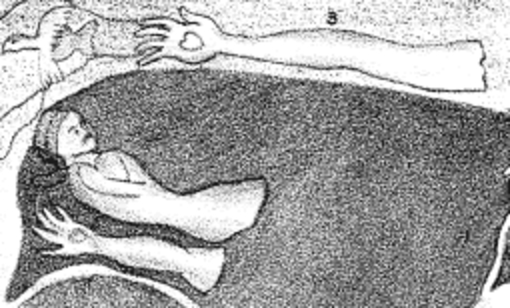
Extract from Royston Cave north wall-carving. Source: Behrend: Beldane Plate 1
Along with severed arms, Royston's carvings also depicted severed hands, possible hearts, two crucifixions and various individuals shown hanged in batches of eight to ten. The reclining centre figure shows signs of being changed from - or carved on top of - a third severed arm.
Similar imagery was recorded inside Bürgstein/Svojkov bottle cave in the Czech Republic. Problematic carvings in both caves have since been obliterated.
Returning to hogbacks...
Historians say: "they are rather short grave stones shaped like Viking houses".
But folklore suggests something closer to: "licks-stones built as part of carcass processing sites".
From Hogback Tombstone Research Journal on the mythology of the Heysham hogback:
Signý beseeches her husband to spare her brothers and to put them in stocks instead of killing them. As Siggeir thinks that the brothers deserve to be tortured before they are killed, he agrees.
He then lets his shapeshifting mother turn into a wolf and devour one of the brothers each night. During that time, Signý tries various ruses but fails every time until only Sigmund remains. On the ninth night, she has a servant smear honey on Sigmund's face and when the she-wolf arrives, she starts licking the honey off
The folklore suggests a sugar-coated story about animal licks.
In Christian literature, it's rare to find depictions of bears eating people. But they are there:
Hogbacks made this easier. Source: Igor The Greek
It's easy to find folklore about serpents eating people. And church 'doom' paintings sometimes show serpents eating 'sinners'.
Seemingly, as part of the Romantics' 18th and 19th century cleansing of history and creation of folklore, church paintings - doom or otherwise - were destroyed, defaced or whitewashed.
So it is with the lick stones and stake stones at 'sacrificial' sites. But not all of them:
Wigtown martyr Margaret Wilson. Source: The Killing Time
The bait was taken but the stake - or a modern replacement - remains:
Martyrs' Stake, Wigtown, Scotland. Source: Scotland's Drowned Martyrs
Folklore seems to carry memories of large hungry serpents and sea serpents. But that folklore may have been fabricated to disguise Atlantic coast memories of humans being sold as food to naval and merchant ships.
And the evidence of efforts to remove lickstones and high crosses is itself less easy to hide. Many show signs of being 'sanitised' 1:
Reconstruction sketch of partially destroyed West Kirby hogback. Source: Clumsy and Illogical - Reconsidering the West Kirby Hogsback
In several hogback cases, their destroyers seem to have given up and buried them. Many were found buried when churches were rebuilt in the 19th century.
Even today, carved stones 'accidentally' disappear. From Medieval Histories - Viking Hogbacks:
There used to be 45 stones, but as late as the 1980s some were lost in connection with the demolishment of the neighbouring Harland and Wolff shipyard. They were simply discarded as debris!
Given their physical evidence, their mythology, and their imagery, hogbacks appear to have been feeding stations for earth-bound animals. Their usually vanished neighbours - the high crosses - appear to have been feeding stations for animals that could perch on a tall shaft.
The patterns carved on hogbacks and the two or three known surviving stone shafts suggest both types of structure were designed to slow down feeding. Baited with human offal, their uneven surfaces would have retained the 'gravy' and turned animal feeding time into a spectacle for onlookers.
From Hogback Tombstone Research Journal:
these monuments were highly visible
The Heysham hogback was found at a site that suggests carcass processing structures were arranged as a spectacle. More on that to follow.
Hogback sites discussed in this evidence collection
Key:
- Blue marker: hogback locations. Yellow: hogbacks originally with high crosses.
- Red marker: Martyrs' Stake
© All rights reserved. The original author retains ownership and rights.
-
Orthodox hogback dating says hogbacks were created in a 30-year period somewhere between 950 AD and 1,000 AD. Oddly, orthodox historians are not inclined to attribute the damage to (and burial of) many hogbacks to the same 17th century iconoclasts they credit with destroying crosses. ↩
More of this investigation:
Away in a Manger,
More of this investigation:
Misunderstood Technology
More by tag:
#human meat, #Manimal Farm
